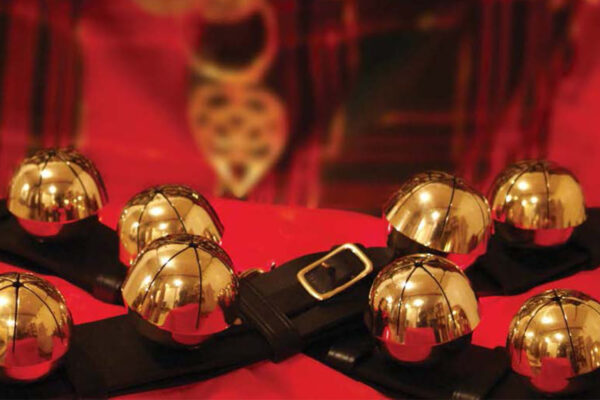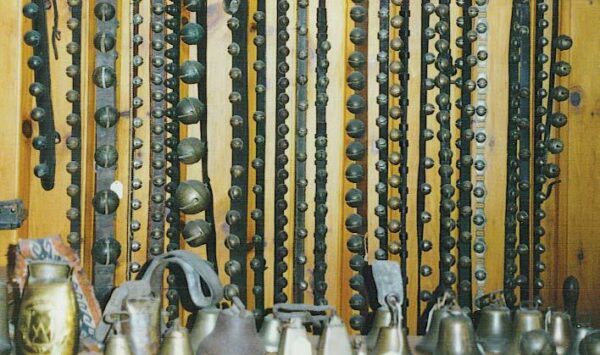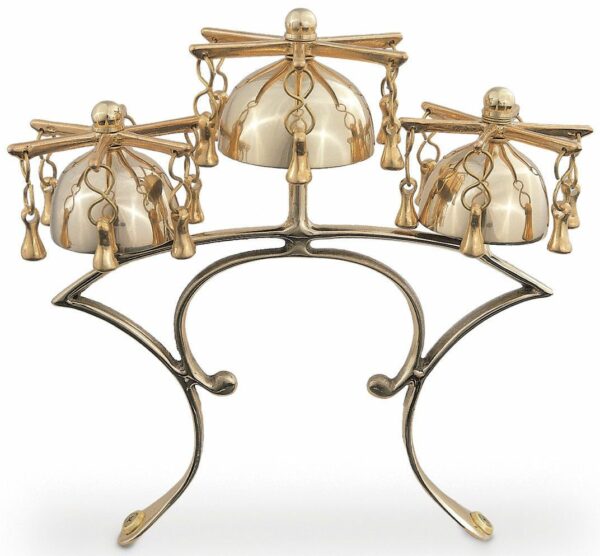 4-chime brass rump bells (which actually lie across the back of each horse and buckled to the breeching strap). In back, horse brasses. Terri Mason collection
4-chime brass rump bells (which actually lie across the back of each horse and buckled to the breeching strap). In back, horse brasses. Terri Mason collection
12 Days of Cowboy Christmas
Sleigh Bells Ring
The History of Sleigh Bells
By Terri Mason
Elaborate bells and ornaments have been used to adorn horses worldwide from at least 800 BC through today. Horse bells were believed to attract good luck, protect against disease, injury and “the evil eye,” flaunted the owner’s wealth and status and enhanced the horse’s natural beauty.
In Britain, horse bells dating to Roman times have been unearthed and authenticated by archaeologists. In the 1500s and 1600s, gold or silver-plated horse bells were engraved with coats of arms and inscriptions and presented as gifts and awards. In North America, makers were manufacturing horse bells as early as the 1700s, and in the very early 1800s, William Barton pioneered a thriving sleigh bell industry in East Hampton, Connecticut and in short time, the city earned the international nickname as “Belltown” or “Jingletown.”
By the end of the 1800s, a process of stamping sleigh bells out of sheet metal was developed, jumping the production rate from 500 cast bells a day to an astounding 25,000 bells in the same time. By the late 1800s, the many bell makers of East Hampton provided 90 per cent of the world’s sleigh bells. Almost all U.S. bell manufacturers went out of business by the early 1900s, and the only North American bell manufacturer established in the 1800s that still is in operation is the Bevin Bros. Mfg. Co. in East Hampton, Connecticut. Horse bells are still used to set a festive tone for a pleasure ride in a horse-drawn sleigh, carriage or wagon. Today, all cast brass sleigh bells are made overseas.

Highway Traffic Laws
In Ontario, sleigh bells are mandated by law and persons breaking the law are subject to a $5 fine. The law states: “Every person travelling on a highway with a sleigh or sled drawn by a horse or other animal shall have at least two bells attached to the harness or to the sleigh or sled in such a manner as to give ample warning sound.” Highway Traffic Act, R.S.O. 1990, Chapter H8
In 1906, Alberta’s first attorney general, J.J. Boyle, made sleigh bells mandatory.
Teamster Pride
If a wagon needed assistance from another teamster, it was common to hand over the bells in thanks. It was a matter of some shame to arrive at your destination without your bells, so much so, that some teamsters would refuse help rather than lose their bells. This was the origin of the saying, “I’ll be there with bells on.”
Bells in Space
“Jingle Bells” was the first song broadcast from space, in a Christmas-themed prank by Gemini 6 astronauts Tom Stafford and Wally Schirra, December 16, 1965. The two astronauts contacted Mission Control with this report: “We have an object, looks like a satellite going from north to south, probably in polar orbit… I see a command module and eight smaller modules in front. The pilot of the command module is wearing a red suit…” The astronauts then produced a smuggled harmonica and sleigh bells and broadcast a rendition of Jingle Bells. Smithsonian Magazine December 2005 pp25ff
How NORAD Started Tracking Santa
The tradition of the North American Aerospace Defense Command or NORAD tracking Santa began in 1955 when Sears- Roebuck placed an ad in The Gazette in Colorado Springs telling kids to dial a number if they wanted to talk to Santa, but the number was one digit off. When the first call came in, Col. Harry Shoup told an eager child he would check the radars for the jingle bell-ringing Santa.
Last year, the multi-lingual tracking website at www.noradsanta.org received 912 million hits from 181 countries, and the Santa Tracking Operations Center answered nearly 55,000 phone calls on Christmas Eve.
Jingle Bells
The term refers to round cast bells, each with a jinglet inside. The rich musical sound of jingle bells is due to the various sizes that emit various sounds. Smaller bells make a higher-pitched tinkling sound; larger bells emit a deeper rumble.
Rump Bells
Contrary to what most people think, rump bells don’t go on the horse’s rump but are draped over the horses’ back and buckled between the back band and the breeching top.
Shaft Chimes
Shaft chimes are made with open bells, called ice cream bells with a clapper inside, mounted on steel straps that are attached to the bottom of a tongue or under the shafts on both sides. To give a fuller, more musical sound they generally consist of four or more bells of graduated sizes.
Saddle Chimes
Saddle chimes are made with ice cream bells held in an arch containing three, four, five or six bells, and are attached to the terrets on the back pad. On a six-horse hitch, the lead team had the five lighter bells, the swing team the four-bell arch and the wheel team the three heavy bells.
(Originally published in 2007)

